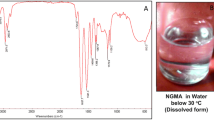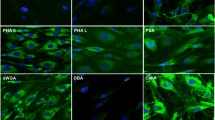Abstract
Bioengineered corneas are substitutes for human donor tissue that are designed to treat severe disease affecting ocular surfaces. However, a shortage of candidate seed cells for bioengineering corneas is still a problem. Bone-marrow mesenchymal stem cells (MSCs) are capable of multilineage differentiation. Therefore, we determined whether MSCs differentiate into corneal epithelial cells (ECs). We applied three exoteric-microenvironmental systems to induce MSCs to become ECs. Induced MSC were identified by means of morphologic examination, immunocytochemical analysis, and flow cytometry. MSCs grown in one microenvironment had characteristics similar to those of corneal epithelial progenitors. Induced MSCs expressed markers for EC, including integrin β1, Cx43, Pax6, and P63. MSCs were successfully induced to become corneal epithelial progenitors. Therefore, the use of MSCs may hold substantial promise for reconstructing the ocular surface after corneal injury.
Similar content being viewed by others
References
Morgan S, Murray A. Limbal autotransplantation in the acute and chronic phases of severe chemical injuries. Eye, 1996, 10(Pt 3): 349–354
Pellegrini G, Traverso C E, Franzi A T, et al. Long-term restoration of damaged corneal surfaces with autologous cultivated corneal epithelium. Larnet, 1997, 49(9057): 990–993
Tsubota K, Satake Y, Kaido M, et al. Treatment of severe ocular-surface disorders with corneal epithelial stem-cell transplantation. N Engl J Med, 1999, 340(22): 1697–1703
Holland E J, Schwartz G S. Epithelial stem cell transplantation for severe ocular surface disease. N Engl J Med, 1999, 340(22): 1752–1753
Tsai R J, Li L M, Chen J K. Reconstruction of damaged corneas by transplantation of autologous limbal epithelial cells. N Engl J Med, 2000, 343(2): 86–93
Li Q J, Ashraf F M, Rana T S, et al. Long-term survival of allogeneic donor cell-derived corneal epithelium in limbal deficient rabbits. Curr Eye Res, 2001, 23(5): 336–345
Solomon A, Ellies P, Anderson D F, et al. Long-term outcome of keratolimbal allograft with or without penetrating keratoplasty for total limbal stem cell deficiency. Ophthalmology, 2002, 109(6): 1159–1166
Reinhard T, Spelsberg H, Henke L, et al. Long-term results of allogeneic penetrating limbo-keratoplasty in total limbal stem cell deficiency. Ophthalmology, 2004, 111(4): 775–782
Sharpe J R, Daya S M, Dimitriadi M, et al. Survival of cultured allogeneic limbal epithelial cells following corneal repair. Tissue Eng, 2007, 13(1): 123–132
Nakamura T, Endo K, Cooper L J, et al. The successful culture and autologous transplantation of rabbit oral mucosal epithelial cells on amniotic membrane. Invest Ophthalmol Vis Sci, 2003, 44(1): 106–116
Lumelsky N, Blondel O, Laeng P, et al. Differentiation of embryonic stem cells to insulin-secreting structures similar to pancreatic islets. Science, 2001, 292(5520): 1389–1394
Zhang S C, Wernig M, Duncan I D, et al. In vitro differentiation of transplantable neural precursors from human embryonic stem cells. Nat Biotechnol, 2001, 19(12): 1129–1133
Chinzei R, Tanaka Y, Shimizu-Saito K, et al. Embryoid-body cells derived from a mouse embryonic stem cell line show differentiation into functional hepatocytes. Hepatology, 2002, 36(1): 22–29
Ali N N, Edgar A J, Samadikuchaksaraei A, et al. Derivation of type II alveolar epithelial cells from murine embryonic stem cells. Tissue Eng, 2002, 8: 541–550
Kawasaki H, Suemori H, Mizuseki K, et al. Generation of dopaminergic neurons and pigmented epithelia from primate ES cells by stromal cell-derived inducing activity. Proc Natl Acad Sci USA, 2002, 99(3): 1580–1585
Chiba S, Iwasaki Y, Sekino H, et al. Transplantation of motoneuron-enriched neural cells derived from mouse embryonic stem cells improves motor function of hemiplegic mice. Cell Transplant, 2003, 12(5): 457–468
Chiba S, Ikeda R, Kurokawa M S, et al. Anatomical and functional recovery by embryonic stem cell-derived neural tissue of a mouse model of brain damage. J Neurol Sci, 2004, 219(1–2): 107–117
Ye J, Yao K, Kim J C. Mesenchymal stem cell transplantation in a rabbit comeal alkali burn model: Engraftment and involvement in wound healing. Eye, 2006, 20(4): 482–490
Guo T, Wang W, Zhang J, et al. Experimental study on repairing damage of corneal surface by mesenchymal stem cells transplantation. Chin J Ophthalmol (in Chinese), 2006, 42(3): 246–250
Ma Y, Xe Y, Xiao Z, et al. Reconstruction of chemically burned rat corneal surface by bone marrow-derived human mesenchymal stem cells. Stern Cells, 2006, 24(2): 315–321
Izadpanah R, Joswig T, Tsien F, et al. Characterization of multipotent mesenchymal stem cells from the bone marrow of rhesus macaques. Stem Cells Dev, 2005, 14(4): 440–451
Pittenger M F, Mackay A M, Beck S C, et al. Multilineage potential of adult human mesenchymal stem cells. Science, 1999, 284: 143–147
Horan P K, Melnicoff M J, Jensen B D, et al. Fluorescent cell labeling for in vivo and in vitro cell tracking. Methods Cell Biol, 1990, 33: 469–490
Fukuhara S, Tomita S, Nakatani T, et al. Comparison of cell labeling procedures for bone marrow cell transplantation to treat heart failure: Long-term quantitative analysis. Transplant Proc, 2002, 34: 2718–2721
Liu J, Song G, Wang Z. Establishment of a corneal epithelial cell line spontaneously derived from human limbal cells. Exp Eye Res, 2007, 84(3): 599–609
Rama P, Giannini R, Bruni A, et al. Further evaluation of amniotic membrane banking for transplantation in ocular surface diseases. Cell Tissue Bank, 2001, 2: 155–163
Kruse F E, Joussen A M, Rohrschneider K, et al. Cryopreserved human amniotic membrane for ocular surface reconstruction. Graefes Arch Clin Exp Ophthalmol, 2000, 238: 68–75
Friedenstein A J, Gorskaja U, Kalugina N N. Fibroblast precursors in normal and irradiated mouse hematopoietic organs. Exp Hematol, 1976, 4: 267–274
Woodbury D, Schwarz E J, Prockop D J, et al. Adult rat and human bone marrow stromal cells differentiate into neurons. J Neurosci Res, 2000, 61(4): 364–370
Liechty K W, MacKenzie T C, Shaaban A F, et al. Human mesenchymal stem cells engraft and demonstrate site-specific differentiation after in utero transplantation in sheep. Nat Med, 2000, 6(11): 1282–1286
Krause D S. Engraftment of bone marrow-derived epithelial cells. Ann N Y Acad Sci, 2005, 1044: 117–124
Tremain N, Korkko J, Ibberson D, et al. MicroSAGE analysis of 2,353 expressed genes in a single cell-derived colony of undifferentiated human mesenchymal stem cells reveals mRNAs of multiple cell lineages. Stem Cells, 2001, 19(5): 408–418
Modesti A, Scarpa S, D’Orazi G, et al. Localization of type IV and V collagens in the stroma of human amnion. Prog Clin Biol Res, 1989, 296: 459–463
Fukuda K, Chikama T, Nakamura M, et al. Differential distribution of subchains of the basement membrane components type IV collagen and laminin among the amniotic membrane, cornea and conjunctiva. Cornea, 1999, 18: 73–79
DiRenzo J, Signoretti S, Nakamura N, et al. Growth factor requirements and basal phenotype of an immortalized mammary epithelial cell line. Cancer Res, 2002, 62(1): 89–98
Vicario-Abejon C, Yusta-Boyo M J, Fernandez-Moreno C, et al. Locally born olfactory bulb stem cells proliferate in response to insulin-related factors and require endogenous insulin-like growth factor-I for differentiation into neurons and glia. J Neurosci, 2003, 23(3): 895–906
Harris R C. Potential physiologic roles for epidermal growth factor in the kidney. Am J Kidney Dis, 1991, 17(6): 627–630
Wolfgang C L, Lin C, Meng Q, et al. Epidermal growth factor activation of intestinal glutamine transport is mediated by mitogen-activated protein kinases. J Gastrointest Surg, 2003, 7(1): 149–156
Rubin A L, Rice R H. Differential regulation by retinoic acid and calcium of transglutaminases in cultured neoplastic and normal human keratinocytes. Cancer Res, 1986, 46(5): 2356–2361
Chang J, Zhang C, Tani-Ishii N, et al. NF-kappaB activation in human dental pulp stem cells by TNF and LPS. J Dent Res, 2005, 84(11): 994–998
Abdallah B M, Boissy P, Tan Q, et al. DLK1/FA1 regulates the function of human bone marrow mesenchymal stem cells (HMSC) by modulating gene expression of pro-inflammatory cytokines and immune-response-related factors. J Biol Chem, 2007, 282(10): 7339–7351
Matic M, Petrov I N, Chen S, et al. Stem cells of the corneal epithelium lack connexins and metabolite transfer capacity. Differentiation, 1997, 61(4): 251–260
Pellegrini G, Dellambra E, Golisano O, et al. p63 identifies keratinocyte stem cells. Proc Natl Acad Sci USA, 2001, 98(6): 3156–3161
Sivak J M, Mohan R, Rinehart W B, et al. Pax-6 expression and activity are induced in the reepithelializing cornea and control activity of the transcriptional promoter for matrix metalloproteinase gelatinase B. Dev Biol, 2000, 222: 41–54
Wolosin J M, Budak M T, Akinci M A. Ocular surface epithelial and stem cell development. Int J Dev Biol, 2004, 48(8–9): 981–991
Heckmann L, Fiedler J, Mattes T, et al. Mesenchymal progenitor cells communicate via alpha and beta integrins with a three-dimensional collagen type I matrix. Cells Tissues Organs, 2006, 182(3–4): 143–154
Nakagawa H, Akita S, Fukui M, et al. Human mesenchymal stem cells successfully improve skin-substitute wound healing. Br J Dermatol, 2005, 153(1): 29–36
Wagers A J, Sherwood R I, Christensen J L, et al. Little evidence for developmental plasticity of adult hematopoietic stem cells. Science, 2002, 297: 2256–2259
Author information
Authors and Affiliations
Corresponding author
Additional information
Supported by the Key Clinical Program of the Ministry of Health of China (Grant No. 2004468), the National Natural Science Foundation of China (Grant No. 30672275), Natural Science Foundation of Guangdong Province (Grant No. 06300679) and the Post-doctor Foundation of China (Grant No. 2005037616)
About this article
Cite this article
Yuan, J., Yu, J., Huang, B. et al. Induction of corneal epithelial progenitors from bone-marrow mesenchymal stem cells of rhesus monkeys in vitro . CHINESE SCI BULL 52, 2216–2225 (2007). https://doi.org/10.1007/s11434-007-0304-z
Received:
Accepted:
Issue Date:
DOI: https://doi.org/10.1007/s11434-007-0304-z




